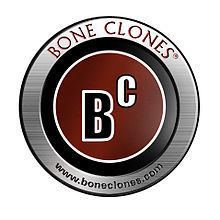Founder Dave Kronen Type of business Private Corporation | Headquarters California, United States Founded 1993 | |
 | ||
Products Natural human and animal bone reproductions | ||
Bone Clones, Inc. manufactures, distributes, and sells osteological reproductions of human and animal bones. Located in Canoga Park, California, Bone Clones provides these reproductions to museums, universities, medical schools, and other educational institutions.
Contents
History
Bone Clones creator Dave Kronen became interested in animals during his career as an artist. During the 1980s, he began processing animals in his Wooodland Hills studio, carefully and painstakingly mounting the skeletons of lizards, snakes, and other animals. With a supply of animal remains from local zoos, museums began to buy the processed skeletons from Kronen. The idea of replicating real bones out of resin casting came from the increasing demand of museums for processed skeletons. The manufacturing of Bone Clones reproductions began in 1993.
Product
Bone Clones reproductions are made from a custom blended polyurethane resin. To avoid misrepresentation, all Bone Clones reproductions are stamped with company trademark information.
Bone Clones in museums and colleges
Bone Clones reproductions have been featured in museums and colleges as part of exhibits and exhibitions. Human reproductions can be seen in the "Footsteps Through Time" exhibit at the San Diego Museum of Man in California. In 2004, Glendale Community College in Glendale, California partnered with Bone Clones, Inc. to create the science exhibit "“Bone: The Hidden Structure of Life." This exhibit showcases skeletons of extinct and extant animals, inviting students and visitors to interact with otherwise inaccessible specimens. In 2012, anthropologist Richard Wright used Bone Clones cast BC-110 to train users in quality control when using his CRANID program for determining the ancestry of unidentified human remains. In February 2014, The American Biology Teacher journal featured an article by Mike Darwin Yerky, who used Bone Clones casts to create an engaging and effective lesson plan in hominin evolution for biology students.
Bone Clones have been featured on television, numerous magazine and newspaper articles and museum exhibitions including:
